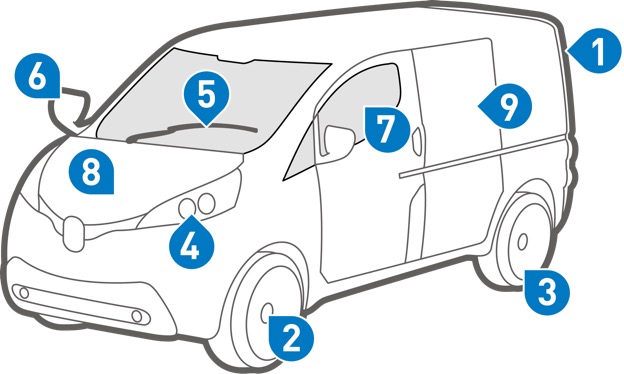Why van safety matters
There are more than 4 million vans on UK roads, helping businesses large and small to thrive.
However, poorly operated and maintained vans are costing businesses millions and throwing van drivers into disrepute. Of the 10,800 vans stopped at the roadside each year:
- 88.5% are overloaded
- 63% have serious mechanical defects
- 50% fail their MOT
If you are driving a van that is not roadworthy or is overloaded, you could face:
- A fixed penalty charge or on the spot fine up to £5,000
- Prohibition of the van.
- Immobilisation of the vehicle.
What you can do?
This can be easily avoided by making sure your van is properly maintained and is not overloaded.
For easy to follow advice, see our daily van maintenance guide below:
Daily van maintenance guide
Make sure your van is properly maintained by carrying out a few simple checks:
Load and towing
Know your van’s maximum payload and make sure that you are not overloading it and that your cargo is properly secured.
Overloading will make the van more difficult to stop and handle and will make the vehicle’s brakes and suspension wear quicker.
When towing, make sure the towbar and trailer are secure and all electrical connections working. If the van has a tail lift, make sure it is free from damage and functions properly.
Brakes and steering
Check that the brake pedal doesn’t have excessive travel and that there isn’t too much play in the steering.
The parking brake must hold the vehicle when stationary and fully loaded.
Tyres and wheels
Unsafe or illegal tyres can result in receiving three penalty points on your licence per tyre.
Make sure each tyre has:
- a minimum tread depth of 1.6mm
- sufficient inflation
- no deep cuts in the sidewall
- no cord visible on the tyre
- no missing or insecure wheel nuts
Lights
All lights and indicators must work correctly, stop lights should come on when the brakes are applied and lenses must be present, clean and the correct colour. Marker lights must also be present and working.
Inside, all dashboard warning lights must work correctly.
Washers and wipers
Windscreen wipers must move continually when switched on and clear the windscreen effectively.
Washers must point at the windscreen and be operational; washer fluid must be topped up.
Mirrors and glass
All mirrors must be properly aligned and secured. Your view of the road shouldn’t be obscured by damaged or discoloured glass.
Seats and seat-belts
Check that seat-belts operate correctly and are free from cuts and damage. Ensure all seats are secure.
Fluids, fuel and oil
Make sure that brake fluid, engine coolant, engine oil, power steering fluid and windscreen washer fluid levels are correct. Ensure there are no fluid- or oil-leaks and that the fuel filler cap is securely fitted.
Bodywork and doors
Check that all doors shut properly and are secure when closed. There should be no sharp edges or damage to the bodywork and no danger of body panels falling off.
For more information on van loading and maintenance, see this van best practice guide by DVSA.









